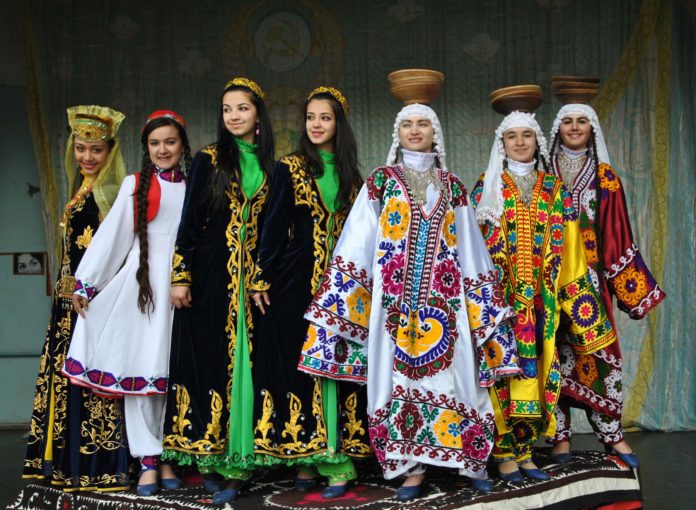This article is written by Lolisanam Ulugova (An independent researcher on Tajika arts and culture).
Dance is an essential part of performing arts, often an essential attribute of theatrical performances,whilst also staying an independent art form.
In the publication “Traditional theater of Tajiks” Nizam Nurjanov1 (12.18.1923 – 18.03.2017) distinguishes two types of dance theaters: the Sozanda women’s dance theater and the Chuwon men’s dance theater, believing that these types of acting began to reveal the spiritual world more in a more fully human manner, and thus became the most important means of ideological and emotional impact on the viewer. These dance institutions have been full of plastic expressions of thoughts and feelings, senses of rhythm and tempo, and spatial patterns of the dance composition.
They paved the way for the development of choreography as cultural foundations.
It is necessary to mention an important detail about these types of theatrical space: that they had different audiences and could not be mixed up in performances. The Sozanda theater had a purely female audience, while the Chuwon theater had an exclusively male audience. Thanks to the Soviet regime, these two types of theater were able to be united in the region, and female dancers and male dancers could dance together on one stage2 . There is one more detail to mention about the Chuwon theater, though. This type of spectacle contributed to the illegal practice of bacha-bazi (playing with boys), a type of sexual exploitation under the guise of dressing up boys from 10-15 years in women’s outfits and entertainment of men’s companies. This practice was eradicated during
the Soviet era in the region, and artistic men could practice dancing without harm to their health and reputation.
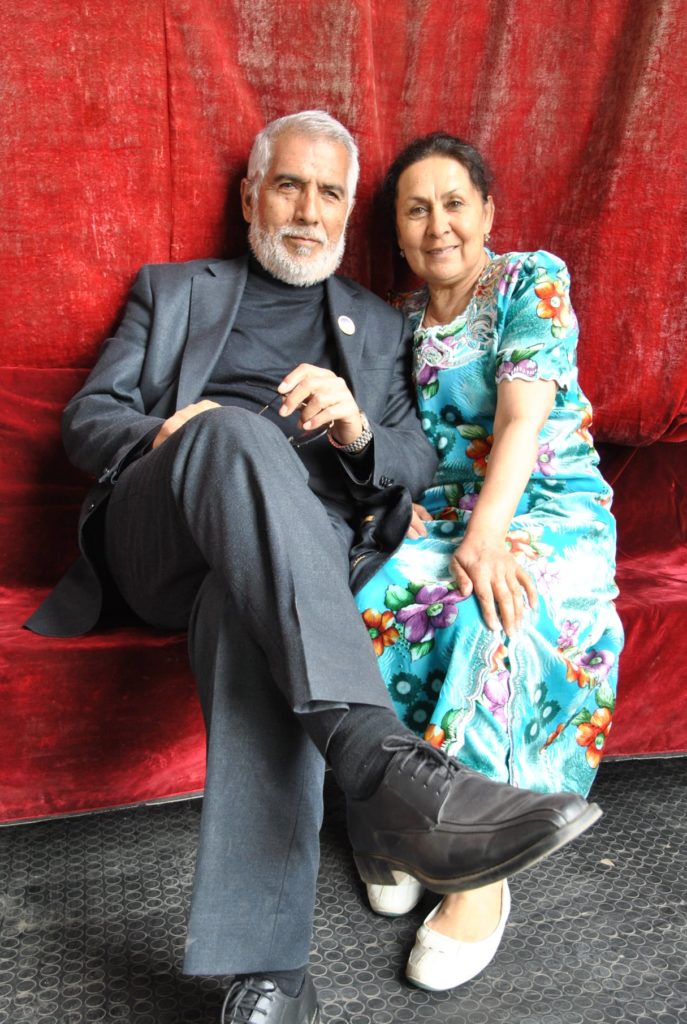
Tajik dance heritage is rich and varied. However, my purpose in this article is to reflect the current state of dance art through portraits of some choreographers who have left a significant mark on the development of the performing arts in modern Tajikistan. I want to acquaint readers with different approaches of Tajik choreographers to understanding dance, ways of transforming it over time, as well as its reflection of society. This article is a portrayal of my era, projected through the prism of the dance heritage. My choice was made by the choreographers Sharofat Rashidova, Amon Musoev,Jamila Akhunova and Zebo Amin-Zade. Undoubtedly, Tajik culture is rich in other notable names of this art form, but I will proceed from my experience of working with the above professionals within Tajik Dance Initiatives, a local NGO.
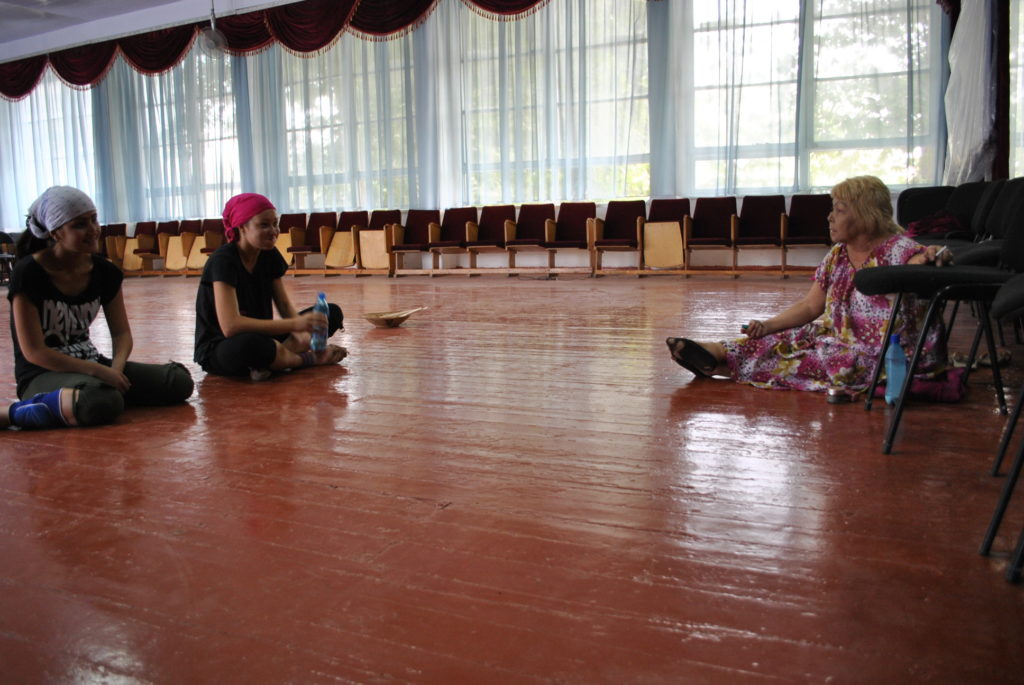
Sharofat Rashidova has been a founder of fusion dance theater My meeting with the choreographer Sharofat Rashidova3 took place back in 2007, just before the meeting with our mutual friend from America, Ms. Sharlin Sawyer4, who had headed the project that
facilitated the dialogue of the cultures of the Tajik and American peoples in those years, who later invited me to her project to lead a local NGO “Tashabbusi Raksi Tojik” (Tajik Dance Initiative). The dynamic mualima Sharofat Rashidova was the embodiment of hospitality, tireless sparkling energy and undoubted courage. ‘Courage’ is an appropriate epithet, because she was the first, with her husband Khabibullo Abdurazakov5 (born 1937,) to create an independent dance theater, the only one of its kind in the country, known as the “Padida” theater (phenomenon), which, since its inception in 2001, brought up a generation of dancers who both loved the dance heritage and were able to find their professional niche in society.
Sharofat Rashidova (born 1948) was born in an ordinary family, “not a creative intelligentsia,” as the choreographer herself admitted in my interview. Since childhood, she loved to dance, to dress up in beautiful outfits. In her childhood, she was profoundly affected by the film “Unknown Woman”6 widely broadcast on Soviet television, where, in addition to the story of the unhappy love of a woman, there was a lot of dances and music, which was a tool for studying Arabic dance for the artist. At the age of 13, she won a dance competition held at the Dushanbe House of Folk Art (Dom narodnogo tvorchestva), led by the legendary choreographer Gafar Valomatzade7 (1916-1993), who later became her educator.
Two years later, Valomatzade began to build his own ensemble Lola (1965), where Sharofat
Rashidova became a permanent soloist, along with the famous Malika Kalontarova. Both of them became an integral part of the glorious history of the state dance group Lola. Mualima (polite addressing) warmly recalls the past years, a group of artists of 40 people, which included Halima Erkaeva, Khosiyat Boyeva, and many other names that left a significant mark in the history of the dance art of Tajikistan. She worked at the Lola ensemble from bell to bell for exactly 24 years (1965-1989) and recalls her ustod (teacher) Gafor Valomatzade and her colleagues in the creative artel with gratitude and pleasure.
Although already retired, at the invitation of international cultural institutions, she staged Tajik dances in many foreign countries. In the UK, in Glasgow for a month, she taught the local theater group the rhythm and movements of Tajik dance. On that tour she was with the famous singer Davlatmand Kholov8 (born 1950), one of the outstanding singers of the traditional genre falak (rock,destiny). Normally, this genre of singing never involved dancing, but it happened there, in Scotland,that a falak dance performance was first created. Then later, she and her husband visited the Netherlands, where they choreographed the dances of wedding ceremonies of southern and eastern Tajikistan, as well as the men’s dance ukob (eagle). The pedagogical talents of Rashidova were highly appreciated there.
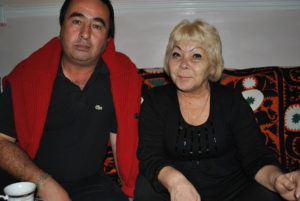
Since 1991, she has headed the Jahonoro ensemble which was affiliated to the State Television and Radio Broadcasting Committee until 2001, when she established own dance theater Padida.Throughout the civil war (1992-1997), Rashidova fearlessly led her peacekeeping mission, teaching young people the most non-violent art forms.
Her mind and charisma are enchanting, and her achievements groundbreaking. In addition to being the first to dare to stage a para-religious genre of the falak, she has been also the first to mix Tajik traditional choreography with American pop culture, making a choreographic performance on the famous Michael Jackson song9 , skillfully integrating the singer’s rhythmic music with traditional Tajik culture, its costumes and dance movements.
As soon as the Padida theater appeared on the horizons of Tajik culture, many foreign
choreographers began visiting this theater, and among them was a French choreographer Laurence Levasseur10. I witnessed their joint production of Pure Water, where the soloist of the Padida theater Maryam Gaibova (nee) for 18 minutes showed the importance of environmental and water protection raising the awareness. Then, for the first time, thanks to Rashidova’s Padida theater, the Tajik audience witnessed the synthesis of traditionalist dance with contemporary modernist dance trends.
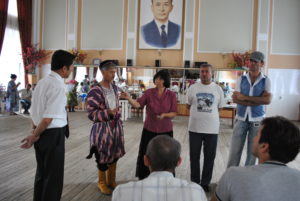 In 2019, her Padida Theater won the main prize in the dance nomination of last year’s Central Asian Talent Show Television Competition11. She told me with enthusiasm about each stage preparation process. “There were three rounds in total, and for each tour we (she and her husband) came up with choreographic stories that would be interesting for the viewer to watch. Within 2.5 minutes it was necessary to tell in such a way that it was both interesting and understandable, and surprising with novelty. It was difficult, but we did it perfectly well”, Rashidova smiled at me. The choreographer has used famous stories of classical Persian literature for his dance plots. The presented final composition Layli and Majnun was the most spectacular and colorful, conquering the hearts of both
In 2019, her Padida Theater won the main prize in the dance nomination of last year’s Central Asian Talent Show Television Competition11. She told me with enthusiasm about each stage preparation process. “There were three rounds in total, and for each tour we (she and her husband) came up with choreographic stories that would be interesting for the viewer to watch. Within 2.5 minutes it was necessary to tell in such a way that it was both interesting and understandable, and surprising with novelty. It was difficult, but we did it perfectly well”, Rashidova smiled at me. The choreographer has used famous stories of classical Persian literature for his dance plots. The presented final composition Layli and Majnun was the most spectacular and colorful, conquering the hearts of both
the audience and the jury of the show.
The Padida dance theater, which arose through the efforts of the Rashidova family in 2001, has been entirely self-financing. The costumes have been sewn by themselves. The repertoire has invented by mualima Rashidova herself (coordinating the plots with her husband, the genius theater and film actor and a formidably encyclopedically educated person, Khabibullo Abdurazakov.)
The building where Padida has been situated is subject to demolition as part of the city’s urban plan.This is the former Green Theater (open air/outdoor theater); it is the same place that the nationwide competition was held under the leadership of Valomatzade in the distant 60s in the 20th century.
After the civil war, many outdoor theaters were closed, and therefore Rashidova optimistically rented the abandoned building to develop the country’s independent modern dance art. She told me that thanks to the President Rahmon that this theater was given to her for educational purposes. “And I justify his trust,” she concludes modestly.
Speaking about her students, Rashidova admits that when they had started performing schooling,there were more girls, now attendance at the dance studio has been decreased significantly. “Mostly orphans came to me, girls of 8-12 years old from low-income families, after 12 years old girls no longer attend the classes, very rarely continue their studies in adolescence,” said the choreographer. “Parents are worried for their girls, they don’t want their daughters to be considered frivolous,” said Rashidova. Where they go after the demolition of the theater building Rashidova does not know yet, but she is optimistic about the future. She is sure that help will come your way anyway, in some form……………………
to be continued.



